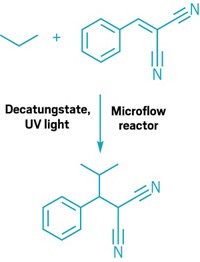Advertisement
Grab your lab coat. Let's get started
Welcome!
Welcome!
Create an account below to get 6 C&EN articles per month, receive newsletters and more - all free.
It seems this is your first time logging in online. Please enter the following information to continue.
As an ACS member you automatically get access to this site. All we need is few more details to create your reading experience.
Not you? Sign in with a different account.
Not you? Sign in with a different account.
ERROR 1
ERROR 1
ERROR 2
ERROR 2
ERROR 2
ERROR 2
ERROR 2
Password and Confirm password must match.
If you have an ACS member number, please enter it here so we can link this account to your membership. (optional)
ERROR 2
ACS values your privacy. By submitting your information, you are gaining access to C&EN and subscribing to our weekly newsletter. We use the information you provide to make your reading experience better, and we will never sell your data to third party members.
Synthesis
Titanium Sparks Ethane-To-Ethylene Conversion ...
by Bethany Halford
July 4, 2011
| A version of this story appeared in
Volume 89, Issue 27
With the help of a titanium alkylidyne reagent, chemists have found a way to make ethylene from ethane at room temperature (J. Am. Chem. Soc., DOI: 10.1021/ja202316m). Ethane is a major component of natural gas, but for uses other than fuel, such as to make polymers or more reactive two-carbon compounds, the saturated hydrocarbon needs to become a molecule with a reactive handle. This feat is typically done by stripping off hydrogen via steam cracking to make ethylene. That process, however, requires temperatures in excess of 800 °C and produces as much as 3 tons of carbon dioxide for each ton of ethylene. Researchers at Indiana University led by and found that they could dehydrogenate ethane at 21 °C using stoichiometric amounts of the titanium alkylidyne shown. The transient organometallic species activates one of ethane’s C–H bonds and then cuts in on an adjacent C–H bond to give a titanium-ethylene adduct. Subsequent two-electron oxidation by an organic azide or nitrous oxide quantitatively releases ethylene.




Join the conversation
Contact the reporter
Submit a Letter to the Editor for publication
Engage with us on Twitter